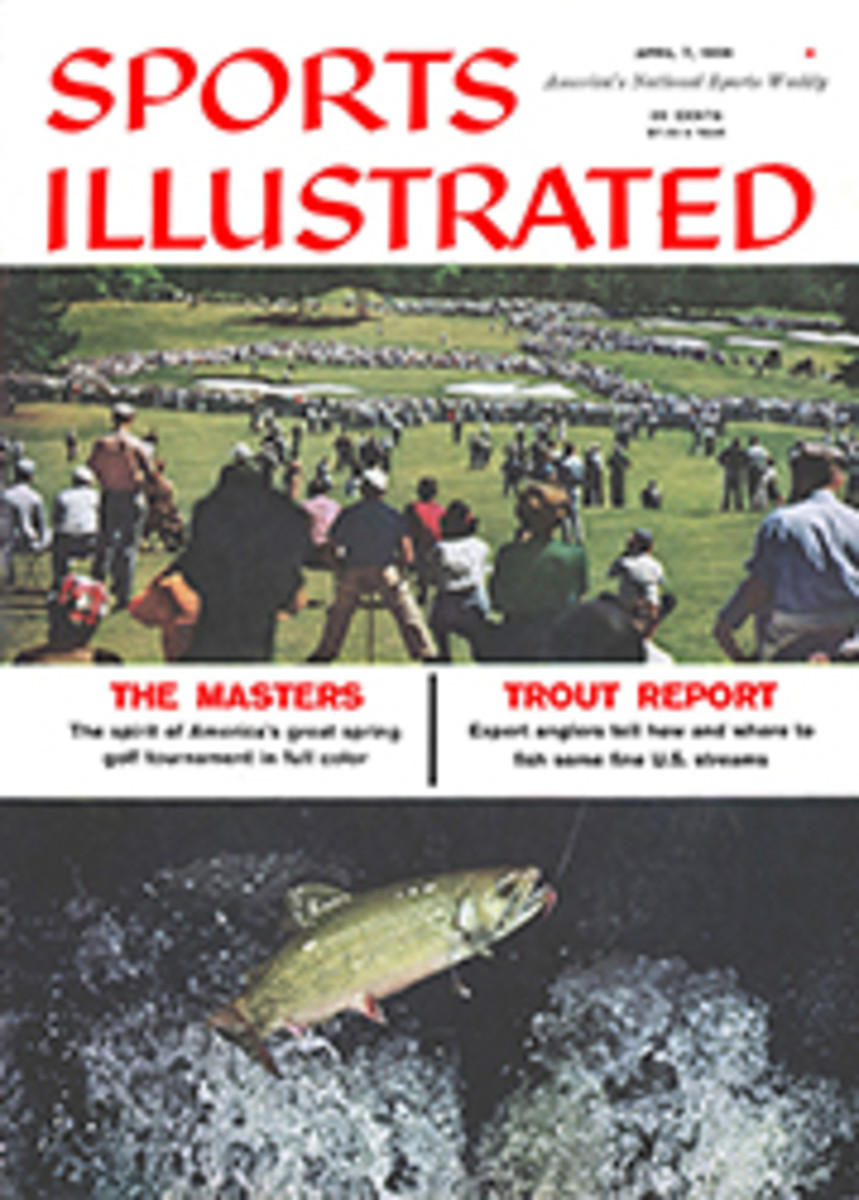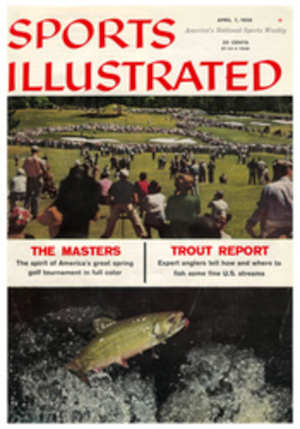
'Wink up and Fiddle'
Master tactician David Arundale, elegant in dinner jacket, club bow tie and gray knee pad, coolly faced the tightly packed crowd of over 600 in Cambridge University's Guildhall and announced with simple dignity, "My men are fit. Whatever form of Goonsmanship we have to face, we have our own secret tactics."
As any close reader of the British press already knew, Mr. Arundale was referring to tiddlywinks. The "Goons," of course, were the Duke of Edinburgh's Royal Champions who last month, with the university's senior proctor, students and townspeople looking on, met the Cambridge Tiddlywink Club in mortal battle. Mr. Arundale was reacting bravely and, as it turned out, with a certain degree of prescience (Cambridge won 120½ to 55½) to a fairly staggering amount of Goonsmanship perpetrated by none other than the duke himself, who missed the match but wired: AT ONE TIME I HAD HOPED TO JOIN MY CHAMPIONS BUT, UNFORTUNATELY, WHILE PRACTICING SECRETLY, I PULLED AN IMPORTANT MUSCLE IN THE SECOND OR TIDDLY JOINT OF MY WINKING FINGER. Prince Philip concluded: WINK UP, FIDDLE THE GAME AND MAY THE GOONS' SIDE WIN.
The much neglected and artful game of tiddlywinks was having a day for itself. Actually, the revived interest in tiddlywinks began when Bill Steen, a thin-faced graduate student in chemical engineering at Cambridge, decided with the aid of a friend that, as they stood little chance of obtaining one of the university's coveted sports "Blues," they might form a tiddlywinks club. To Steen's utter surprise, his father, a Cambridge don, encouraged the idea, and in January 1955 the first club meeting was held. The Cambridge tiddlywinkers, as they called themselves, designed a club tie (dark background with light blue pots and descendent gold winks) and set out to discover the history of the noble game. Their conclusions: Stone Age men may have played an occasional game while chipping flints. The French had something similar to tiddlywinks as early as the 18th century, but since the sport is known disparagingly as "the flea game" on the Continent, the game's real home is in England. Tiddlywinks came to England about the time of the Industrial Revolution, when carpets, essential to playing, first became plentiful. This supposition has been authenticated by the discovery of an English manufacturer who has been producing winks, as the disks are called, for over a hundred years.
Rules for the game are embarrassingly simple, a fact the Cambridge devotees manage to conceal under a superfluity of pseudotechnical nomenclature. The tiddlywink arena is called a pitch and is normally a 6-by-3-foot carpet. The receptacle for winks, placed in the center, is about 1½ inches high and 1¾ inches in diameter. Each tiddlywinker plays with two large and four medium-size winks and, to hoist them, uses a wink of suitable size. It is called a squidger.
A tiddlywinks team normally consists of eight men playing as four pairs. Players of two opposing pairs place their winks in the pitch's four corners, partners opposite each other. Each takes a first round shot at the pot. Starting with the one closest, turns are taken clockwise and the aim is to "wink out," that is, to sink all one's winks. First person to do so scores five points, next three points, third two points and fourth one. In a complete match, each pair should play each of the opposing pairs.
If a tiddlywink lands on another during a game, the one beneath cannot be played until the covering wink is removed. If both members of a pair have all their winks covered, they are said to be squopt. This entitles the opposition to three moves for each of its winks not engaged in covering. When these moves are exhausted, one wink belonging to the opposition has to be released.
Each Cambridge club member is expected to master four basic strokes. The initial shot is the difficult long drive from the corner. Measuring approximately 3‚Öì feet in length, a wink up from this distance is almost, but not quite, as rare as a hole in one in golf. Two strokes more readily mastered are the approach shot and the short putt. A softer, slightly vertical squidge is the proper form here. Fourth in the tiddlywinker's equipment is the cover-up shot, a delicate maneuver which, if successful, places a wink atop an opponent's. All other strokes (e.g., the backwards and sideways squidges and the illegal "down-the-tie" shot, which is squidged into a player's tie so that it slides down into the pot) are derived from these and can only be acquired through experience and much hard practice. To keep squidging muscles in supple condition before a match, Cambridge tiddlywinkers twiddle their thumbs during lectures.
In its infancy the club quickly verified that a mat is the factor which makes a wink rise. It also found that pile carpets suffer fatigue. At least once, a descent was made on the showroom of an unsuspecting Cambridge carpet dealer, where winks were systematically squidged on all the samples displayed. It was eventually decided that a carpet which is suitably resilient and yet has no pile is best.
In further researches, this time involving winks alone, an immense difference in shapes, diameters and thicknesses was discovered. Even in apparently uniform sets, sometimes "borrowed from small brothers and sisters for an indefinite period," measurement has often shown one wink is twice as thick as another. Such "frivolousness" on the part of manufacturers is condemned by the club, which hopes to establish uniform standards. By its definition, the optimum tiddlywink shape and nature is 1½ to 2 millimeters thick, 16 to 22 millimeters in diameter, has flat, smooth surfaces, beveled edges and is constructed of plastic.
The Cambridge club has also considered spin (which it says is forward after squidging) and rolling—nothing is more frustrating than to successfully get a wink near the pot, only to see it roll away. During one particular study, several winks were squidged from an upstairs college window and observed as they fell. It was noticed that spin increased with increased speed, but the axis appeared to remain constant. A deduction has yet to be made.
Opposition has been hard to come by. The Cambridge club has sent out invitations to, among others, Harvard and Yale and Moscow, Peking and Tokyo universities, the Scott Polar Base and the Speaker of the House of Commons. It was a fortuitous headline in a British journal—DOES PRINCE PHILIP CHEAT AT TIDDLYWINKS?—that brought the Duke of Edinburgh and the Cambridge tiddlywinkers together. The club wrote to him, suggesting he appoint Royal Champions to scotch the canard once and for all. The duke, a subtle man, asked some British comedians, the Goons, who specialize in a surrealistic form of fun (it consists of quips, unearthly chuckles, gurgles and squeaks and is popular with a huge British audience) to defend his royal honor, the proceeds of the match to go to his favorite charity, the National Playing Fields Association.
Cambridge Club President Arundale attributes his great victory to a formula his teammates developed for squidging a wink into the pot: R equals P plus A plus S, R being the normal reaction of "the isotropic compressible medium, or carpet"; P being the applied force; A the angle between the wink and the squidger; and S the "steen factor." Mr. Arundale, playing it cozy, did not choose to elucidate what, precisely, he meant by the steen factor.
Will there always be tiddlywinks? Yes! reply the tiddly winkers, and an undergraduate wrote a tune to prove it. At the match's end everybody, including the audience, joined in singing, to the tune of Men of Harlech, the Tiddlywinks Anthem:
Other nations are before us,
With their Sputniks and Explorers.
What can confidence restore us?
Nought but Tiddlywinks.
On the fields of Eton
Former foes were beaten.
But today all patriots play,
This sport which needs such grit and concentration.
Through the game of skill and power,
England knows her finest hour;
And her stronghold shield and tower,
Must be tiddlywinks.
PHOTO
FRONTAL SQUIDGE, executed by David Moreton, is basic tiddlywinks maneuver.
PHOTO
SIDEWAYS SQUIDGE, delicate winking shot, is assayed by Malcolm Hurleston.
PHOTO
CHALK TALK is used by Hugh Mellor to expound the basic tiddlywinks theory.

